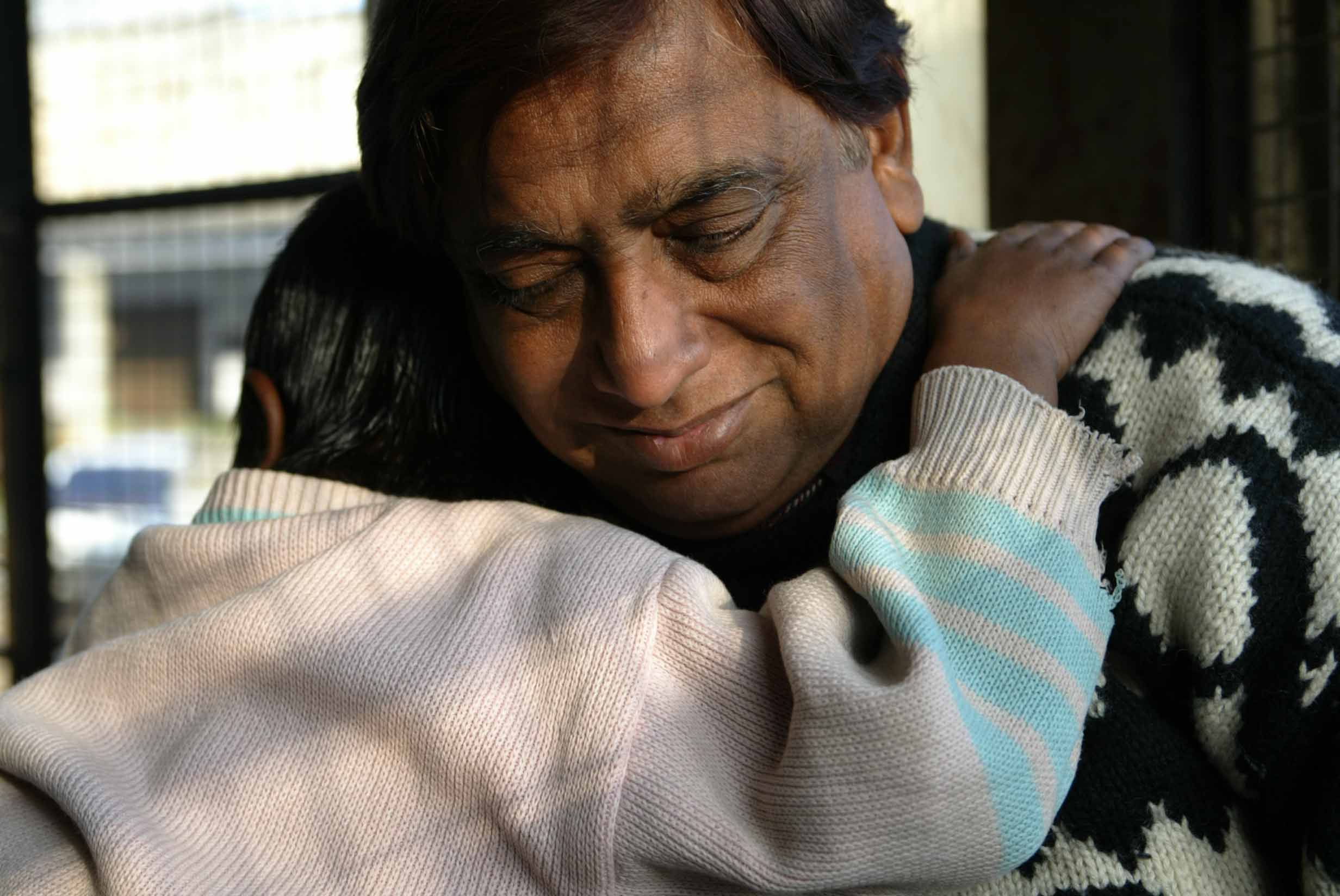
ALLAHABAD, India (BP)–Shobha has sad eyes. Tired eyes.
Not dead eyes, yet. But dying. The heavy makeup on her face can’t hide it.
She sits in a doorway at the end of a grimy lane in Allahabad, a city in north India, and warms her hands over a brazier against the chill. A dingy sweater the color of faded peaches covers part of the garish blue sari she wears to attract customers.
Her 4-year-old daughter, Aiesha, alternately hugs her knee or plays a few steps away.
It’s a slow day. The cold wave — or the recent police raid on the area — has temporarily driven away clients for Shobha and other prostitutes huddling in other doorways nearby. A narrow strip of clear sky is visible above the soot-covered, crumbling colonial buildings that hover over the street. But it seems impossibly far away.
Sometimes Shobha entertains one man a day, sometimes five, sometimes more. The going rate is 30 to 50 rupees per visit, about $1. A healthy percentage of her income goes to the local madam and other assorted pimps and middlemen.
She came to Allahabad’s red-light district eight years ago, Shobha says, because her family was poor and she was hungry. She doesn’t say whether her father pushed her — or sold her — into the flesh trade. Such transactions are common for rural families in Uttar Pradesh, India’s most crowded state — and one of its poorest.
SELLING THEIR DAUGHTERS
Village parents often sell a young daughter outright to sex traffickers, who can make a tidy profit by selling her in turn to urban pimps and brothels. You can buy a village girl in Nepal for 10,000 rupees (little more than $200) and sell her in Delhi for up to 60,000 (nearly $1,300), “depending on her color, texture and size,” says an observer of the trade.
Sometimes, he adds, parents “mortgage” a daughter for a contracted period — usually several years. By the time they save the money to redeem her (if that time ever comes), “she has suffered a lot.”
Shobha hopes her own daughter, who lives in her home village with relatives, can escape the life she has led. As for herself, she says, “I have no hope. I have only this place.”
Shobha claims to be over 30, and looks it. But local prostitutes — more than 1,100 reportedly work in Allahabad’s main red-light area — often say they’re older than they really are.
“These girls usually start around age 14,” says Qamar Joy Zaidi, a local Christian leader who has aided many women trapped in the trade. “By the time they are 18 or 19, they’re finished.” Physically exhausted, dead inside.
That’s why Joy, his wife, Grace, and their team of mostly female volunteers try to rescue girls from prostitution while they’re young — or better still, before they become entangled in the business in the first place. Otherwise, he says, they become “hardboiled eggs,” essentially beyond reach.
Like Shobha.
‘IT’S HER FATE’
Or Tina, who works a few streets over. Her mother also worked in the flesh trade, she admits. So do her sisters. It’s a caste tradition that goes back as long as anyone can remember. What about her infant daughter? Will she continue the generational pattern when her time comes?
“Yes,” Tina answers with chilling matter-of-factness. “It’s her fate.”
Sunita, a veteran prostitute from the neighboring state of Rajasthan, also was pushed into the trade by her family. But she has higher hopes for her children: education, maybe a sliver of land for them to live on if she can save enough money.
“What I have done, I have done, but my children should not come here,” she says, staring out the window of her madam’s upstairs room.
Sunita would leave herself — if she could. But prostitution provides what little acceptance and security she has in this society. If she left, she would have nothing.
“Where would I go?” she asks. “We don’t want to be in this trade. But we have to survive. We need another vocation. We need education.”
WHAT THEY NEED MOST
Food. Shelter. Acceptance. Freedom from violence, AIDS and other sexually transmitted diseases. Literacy. Job skills. Basic civil rights. That’s what these women need to have any hope of breaking the bonds of sexual slavery.
Most of all, they need the saving love of Christ.
Joy and Grace Zaidi have waged a long, often lonely struggle to help women and children victimized by the vast Indian sex industry. They’ve made some enemies along the way. So far, they’ve received little support from the minority Christian community in north India. Respectable pastors don’t want to be seen with prostitutes. Congregations don’t want them showing up in church on Sunday.
When scandalized church folks question Joy about his ministry, he answers with a question: “Didn’t Jesus do this?” When prostitutes ask, “Why do you help us?” he tells them what God has done for him.
Joy can deal with opposition. Years ago he was jailed for criticizing Indira Gandhi, India’s late prime minister. In his jail cell, he recounts, “I found the living Christ.” Grace, a widely respected community leader, ran for mayor of Allahabad a few years ago (she lost, but garnered thousands of votes in a surprisingly strong race).
Needy people of all kinds — especially women and children — find shelter and solace in their home and through several social organizations they lead. Their telephone often rings late at night about another female victim of a beating, burning or rape. Grace has helped hundreds of Indian women form economic cooperatives to escape destitution.
Together, they form a Christian “power couple” in Uttar Pradesh — and a significant force for positive change. But they’re grandparents now. “I’m getting old,” Joy protests with a trademark wry grin. They could use some help. They’re starting to get it from some evangelical friends, including Southern Baptists, who want to see the Gospel spread among both Hindu and Muslim families in Uttar Pradesh, home to 166 million people.
Joy, whose father was a Muslim, has excellent contacts in both the Hindu and Muslim communities, particularly in Varanasi, a city holy to Hindus that has a large Muslim minority. There he partners with an organization that aids Muslim women in need. And, like other Indian women, they have many needs.
TRADITION DIES HARD
Tradition, particularly in a land as old as India, dies hard. Half a century after India became the world’s largest democracy, countless women remain little more than property, forced laborers, objects of exploitation. They have few rights under the law — which is seldom enforced anyway in many parts of north India. That goes for Hindus, Muslims, even minority Christian women. To become second-class citizens would be a step up.
“The birth of a girl here is a burden, not a joy. If she is born first, it is a curse,” Joy explains. Often she is not even fed properly, much less loved, nurtured and educated. Mortality and suicide rates for Indian women are among the highest in the world.
Those factors, along with poverty and geographical location, contribute to the sex industry in Uttar Pradesh. Joy describes the region as a “big bowl” into which are poured thousands of children and young women lured, sold or kidnapped from within the state as well as from neighboring Rajasthan, Madhya Pradesh and Bihar and across international borders from Nepal, Bangladesh and other countries.
Once there, they are forced to service local customers as well as the multitudes of pilgrims who flock to the state’s sacred sites. Religious sanction and caste, indeed, are ancient sources of Indian prostitution. Young girls have long been “dedicated to the god” as Hindu temple prostitutes, which gives village men — often relatives — license to use them sexually.
“They are exploited by the priest for a few years, then thrown out of the temple and forced into prostitution” on the streets or in brothels, Joy says.
How to break the cycle? By fighting for the right of all Indian women to be treated like human beings. By helping them change what so many see as their “fate” of abuse and exploitation. By cherishing them as children of God, deserving of love because He loves them. By demonstrating His love in a way they can see, understand and respond to in faith.
“These are my people,” Joy says. He sees them as the rejected, invisible seeds of the future church in north India. If other Christians join him in serving them, he may be right.
–30–
(BP) photos posted in the BP Photo Library at http://www.bpnews.net. Photo titles: PAPA’S PASSION, SEEING THE NEEDS, HER EYES and WAITING.
















